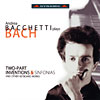|
|
 |
||||||||
 |
Preceding the French Suite are the inventions and sinfonias, whose ubiquity as teaching material means that they are all too often taken for granted. Not by Bacchetti, however, who teases out the rhythmic and harmonic subtleties of both these cycles while also ensuring that the three-part texture of the latter sequence has exemplary clarity with no lack of subtle shading. Following the Partita, meanwhile, are several sets of shorter preludes whose purpose is more inherently didactic, though there is nothing routine about Bacchetti's vibrant handling of those from the Clavierbüchlein that Bach compiled for his son Wilhelm Friedemann, while the closing quartet of Preludes and Fughettas is unalloyed pleasure: the E minor (BWV900) having an expressive poise that would hardly be out of place in the composer's more extended pieces from that genre.
As
befits the playing, the recorded sound lacks nothing in clarity or
immediacy yet never veers to the harsh or unyielding in its capturing of
Bacchetti's tone. The booklet note is succinct but informative and
readably translated, while the booklet presentation makes no attempt to
situate the performer above the music. Strongly recommended, not least to
those performers and listeners who have investigated the '48' or the
Goldbergs and are looking to further their exploration of Bach's
endlessly absorbing keyboard output, to which Bacchetti will hopefully
return in due course. RICHARD WHITEHOUSE |
|||||||
|
Andrea Bacchetti (pf). Dynamic CDS 629/1-2, two discs 151 minutes
|
||||||||
 |
Andrea Bacchetti is a pianist at home across the whole extent of the piano literature, with his Bach playing well able to rank alongside the finest present-day exponents, |
|||||||
| as those who are familiar with his DVD of the Goldberg Variations will surely concur. It's an impression this Dynamic release - intelligently programmed so that each disc features contrasting multi-movement works - amply consolidates. The first disc ends with the Sixth French Suite, one of Bach's most characterful in being literally a succession of dances, rendered here as a diverse yet integrated whole. By contrast, the second disc begins with the Second Partita, whose powerfully rhetorical Sinfonia is indicative of its overall seriousness of conception, and whose intensity Bacchetti sustains through to the coruscating virtuosity of the Capriccio. | ||||||||
|
|
||||||||